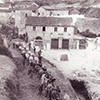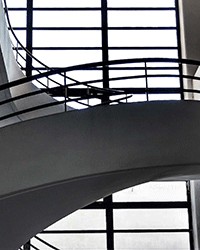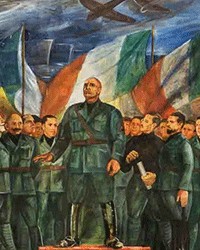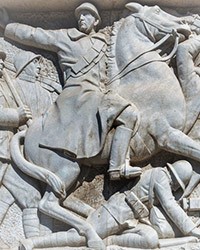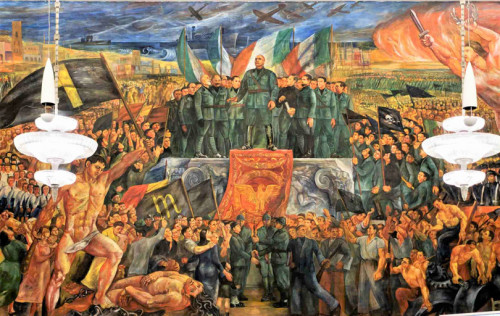
A painting of Mussolini in the former Opera Nazionale Balilla located next to the Mussolini obelisk
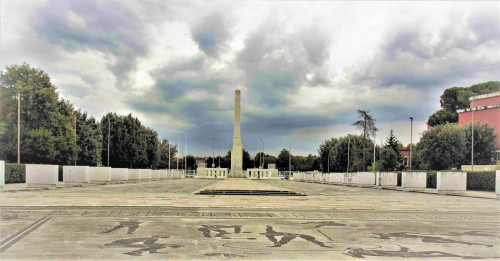
Mussolini's obelisk at Foro Italico (former Foro Mussolini)
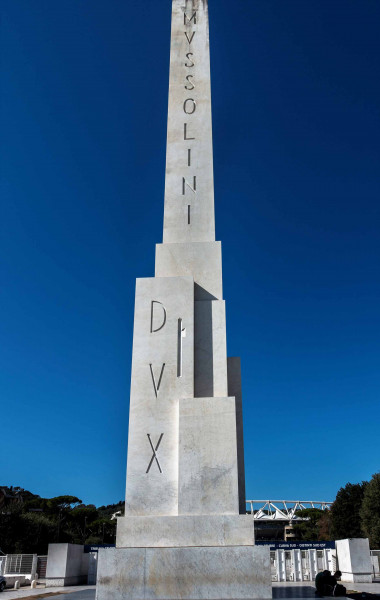
Mussolini's obelisk at Foro Italico
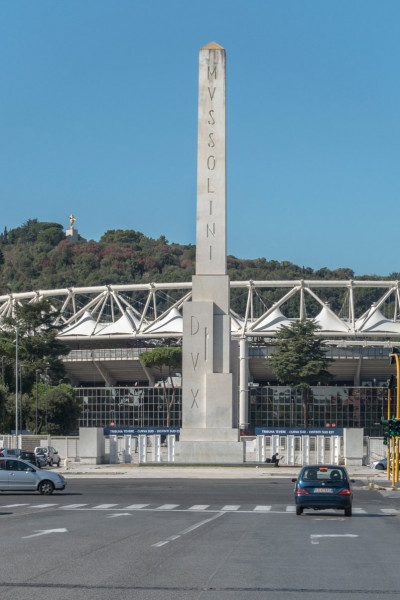
Mussolini's obelisk at Foro Italico (former Foro Mussolini)

Transport of Mussolini's obelisk from the quarry, pic. Wikipedia
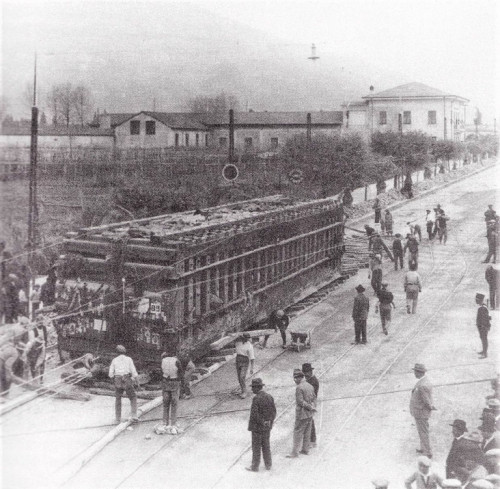
Transport of Mussolini's obelisk, pic. Wikipedia
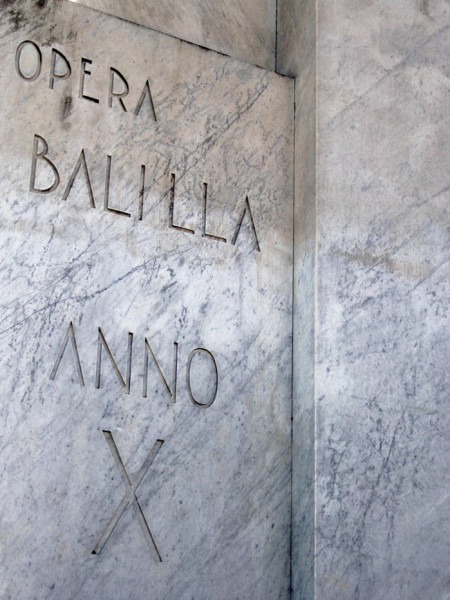
The inscription at the base of Mussolini's obelisk
We cross to the other side of the Tiber river, where a snow-white obelisk with a noble form commemorates the leader and creator of the Fascist state – “the Iron Prefect”, and "the spiritual leader of Europe", as the then propaganda referred to him. Film chronicles provided information about each stage of the transport of the marble block from Carrara as it happened, showing the throngs of tired yet joyous Italians who took part in this memorable event. With the eyes of the whole nation upon it, a momentous act of glorification of Mussolini was taking place – "the providential father" of Italy, who had funded the monument himself. As it would seem for all eternity.
We cross to the other side of the Tiber river, where a snow-white obelisk with a noble form commemorates the leader and creator of the Fascist state – “the Iron Prefect”, and "the spiritual leader of Europe", as the then propaganda referred to him. Film chronicles provided information about each stage of the transport of the marble block from Carrara as it happened, showing the throngs of tired yet joyous Italians who took part in this memorable event. With the eyes of the whole nation upon it, a momentous act of glorification of Mussolini was taking place – "the providential father" of Italy, who had funded the monument himself. As it would seem for all eternity.
The obelisk was placed in a very significant location – upon Mussolini’s Square (Piazza di Mussolini), which is today known as Foro Italico, in the middle of a sports complex, on the north-western edge of the city, at the foot of Monte Mario. It is best visible from the Duca d’Aosta Bridge. From a distance, we are greeted by a vertically engraved inscription MVSSOLINI DVX (Mussolini – leader), and the symbol of the Italian fascists – fasces (a bundle of rods with an ax). Each letter is nearly a meter high and cuts 5 centimeters deep into the stone.
Obelisks had been a part of the Roman landscape since ancient times. They were funded or stolen from Egypt by Roman emperors since they ensured Rome with divine intervention. And even the popes did not tear down these pagan artifacts, using them to commemorate their own deeds. Was it possible for Benito Mussolini – the builder of the Third Rome to choose a better form of immortalizing his glory and keeping the memory of his work alive? Probably not. The monumental, nearly 18 meters high block or marble, which weighed almost 300 tons and finished off with a gilded top, was placed in the central location of the forum bearing his name, just as the statue of Augustus was placed in the central location of the Forum of Augustus, while Trajan’s Column stood upon Trajan’s square. In this way, Duce found himself on equal footing with other Roman emperors – with his own forum and monument.
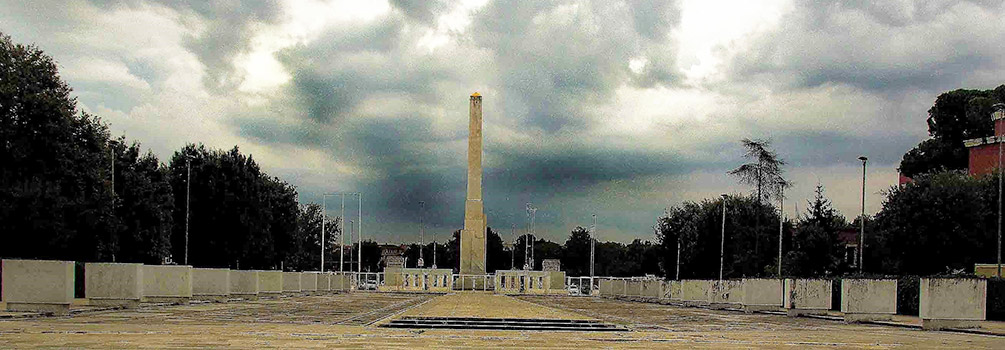
Works on the obelisk started in 1928, meaning six years after Mussolini took over power in Italy. In the Apuan Alps, near Carrara, an ideally pristine, bereft of cracks and colorings stone was found, out of which a block with the dimensions of 19.0 by 2.35 by 2.35 meters was cut out. Then it was secured with a wooden frame and with the aid of 36 oxen was pulled off the 800-meter high mountain and transported all the way to the port (Marina di Carrara). In order to accomplish this 70 liters of liquid soap were used, while the whole operation lasted eight months. From there, freed from the frame, the marble was moved to a specially constructed barge filled with sand. The slow-moving vessel floated onto the Tiber River. When it arrived at the shore the obelisk was unloaded and tractors were used to bring it to its final destination. There it was “dressed” into steel scaffolding and later with the use of a hydraulic lift placed on a previously prepared plinth. The specific, technical information regarding this undertaking is described as if it was written in times when with great struggle and sacrifice obelisks were transported to Rome from Egypt.
The monument whose creator is Constantino Constantini was placed upon the axis stretching from the shore of the Tiber and it was the first element of a great sports complex created here with the Olympics of 1940 in mind. Next to it was the Fountain with a Sphere (Fontana della Sfera) and the Olympic Stadium (Stadio dei Cipressi). The pedestal was unveiled on the 4th November 1932 – precisely on the tenth anniversary of Mussolini's ascension to power. This was also the official date of the opening of the aforementioned complex. Italy was to amaze the world with its power and culture, exquisite art, and the excellence of materials used, meaning the ever-present marble underlining the connections between Fascist and antique culture.
A metal box was placed under the obelisk (it is still there today) with a Latin text written upon the parchment, which was to be a message for future generations. It glorifies the deeds of Fascists, especially Mussolini, while also describing the city of sport and the monument itself created thanks to him. There is also some information about the Fascist youth organization which brought together children aged 8 to 14 (Opera Nazionale Balilla), whose residence was found nearby. In addition, the box also holds a medal depicting Mussolini with a lion's mane upon his head (the symbol of Hercules) – the same way Roman emperors were immortalized in the past.
After the proclamation of the Italian Empire by Mussolini in 1936, the axis which ran between the obelisk and the stadium was given the form of a 280-meter long track known as the Piazzale dell'Impero (presently Viale del Foro Italico), whose creator was a young architect, who was just beginning his career, Luigi Moretti. The surface of the Piazzale was covered with slabs, between which mosaics were placed, depicting athletes as well as images of men with their right hand raised (the Roman salute), scenes showing the deeds and the phases of development of Fascist Italy, and a never-ending litany of slogans (264 in total) such as Duce, Duce a noi (Duce with us), Molti nemici – molto onore (Many enemies – much honor), and similar sentences expressing unity and devotion to the leader, the “Iron Prefect”. The square was flanked by marble cubes. This created and still creates the sensation of majesty and dignity. In this way, a place of the cult of Duce and his state was created. The planned, 100-meter high, colossal monument with facial features of Mussolini was to be the final accent of these prestigious arrangements. Its completion was halted by the war.
Today such symptoms of megalomania are difficult to understand, especially because we are not dealing with ancient times, but with an event that took place less than one hundred years ago. Let us try and understand, how Mussolini who was executed in a shameful way, being hung on a bridge in Milan, and who in 1945 was deemed as an enemy of the nation, did not lose the monument built to commemorate him, while the mosaics which praise him are still around today. The renewed, shining with white marble obelisk greets visitors wanting to reach the stadium and the home of two sports clubs – AS Roma and S.S. Lazio. At night, when illuminated it shines with the eternal memory of the co-director of one of the most ruthless wars in the history of mankind. Why were his bloody slaughters in Africa forgotten, thousands of Italian soldiers killed at the front, to not even mention destroying freedom of the press and subjecting the society to omnipotent and lying propaganda?
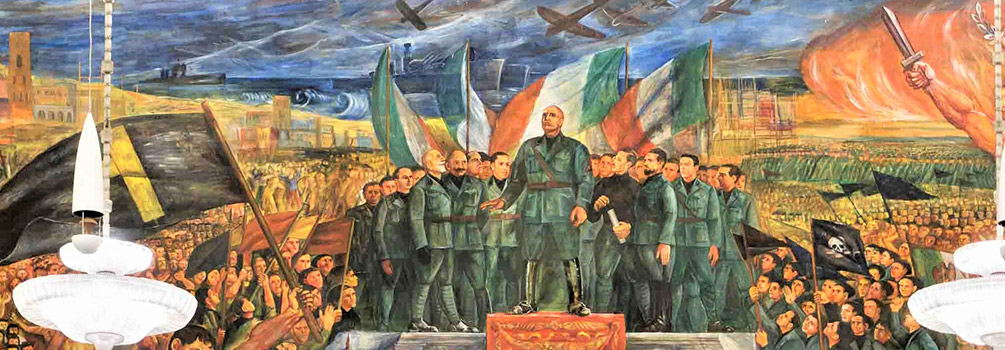
As was mentioned previously, the obelisk was an integral part of the complex devoted to sport, meaning a discipline that served the presentation and propaganda of the Fascist Party. Sport was a means of controlling the youth, which from the youngest years was brought together in Fascist sports clubs and later in paramilitary units. It was an important element in the process of forming a new man – a fascist. After the war, there were rumors of destroying the obelisk, but that is all. The surname of the man whom it commemorates was also left untouched as was the inscription proclaiming the devotion of the youth paramilitary Fascist organization the Opera Balilla Anno X, engraved on the pedestal on the tenth anniversary of the March on Rome.
In 2006 the Olympic Committee (residing nearby) commissioned a renovation of the Foro Italico along with its mosaics and the restoration of the obelisk, which was estimated to cost 2.2 million euros. In 2015, the left-wing chairwoman of the Chamber of Deputies Laura Boldrini in one of her speeches in a marginal way referred to the obelisk and expressed the opinion that the inscription upon it commemorating Mussolini should be removed. The discussion which developed included almost everyone, starting with art historians and ending with nameless defenders of the monument, whose posts (often full of hate) filled the Internet. It would seem that the thoughts of a great majority of the public opinion were expressed by one of the representatives of the Democratic Party (Matteo Orfini) who stated that, Italy as a democratic state does not have the need to erase its own past. The group of defenders included those who believed that such a kind of barbaric, already known in the time of the pharaohs damnatio memoriae has no place in a democratic state, while the obelisk along with other fascist buildings is a monument of history, a national treasure, and evidence of the continuation of national existence. It is as if Mussolini was only remembered as a great builder, a good host, and an energetic man fighting against mafia and malaria. The image of the regime which he was responsible for and which lasted more than twenty years has been forgotten by most Italians – what remained was a nostalgia-filled memory of security and greatness. The times of terror and oppression were those of the German occupation of Italy (September 1943 – May 1945) and not the long-lasting alliance between Mussolini and Hitler which started in 1936. Thus, the role of the victims replaced the role of those who were responsible for World War II.
Mussolini's reign left an unprecedented mark on Rome. He changed the face of the city. In destroying whole districts, streets, churches, and building new wide streets he dismantled the medieval tissue of the city. The ruthless machine of censorship meant that no one was even able to question his mostly barbaric modernization. Today the removal of an inscription seems to be an act of vandalism. However, it is possible without destroying and removing signs of the past – in places that specifically attract fascist sympathizers - to create "places of reflection", which would show that the history of a given nation is also filled with dark and shameful periods. Otherwise, nobody will know who was the hero and who was the oppressor.












